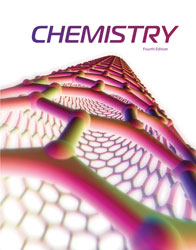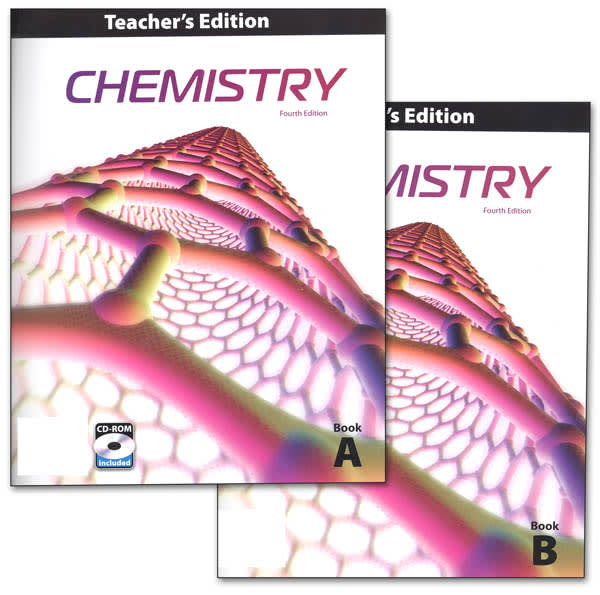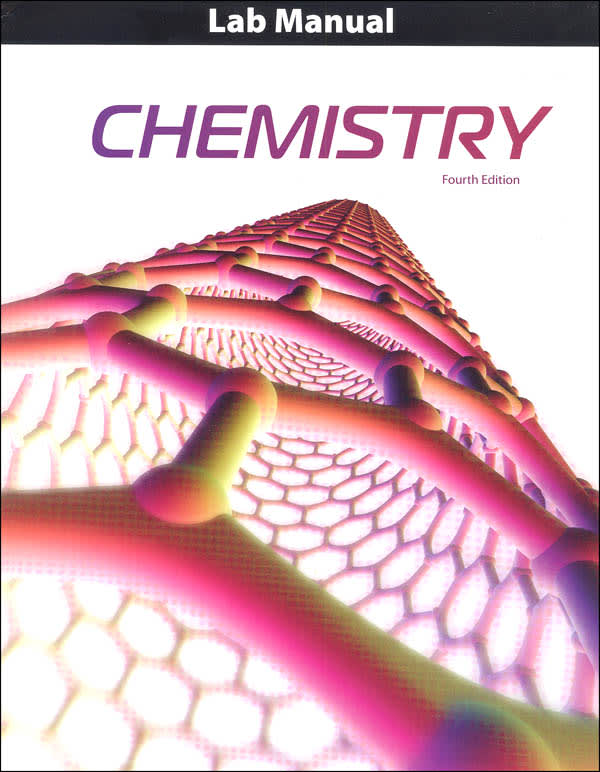BJU Press offers a solid, college prep chemistry lab course. It consists of a student text and a two-volume teacher edition that includes a supplemental CD-ROM with essential resources for the course. There are also tests, and answer keys for the tests. A student lab manual and a teacher's lab manual are designed for classroom use with a full lab, but BJU Press has partnered with Quality Science Labs to create a Logos Science Lab Kit for Chemistry that works with this specific course and adapts lab work for homeschool and small school settings.
Although it has been organized to work in homeschool situations as well as in traditional schools, BJU Press's Chemistry might be difficult for a parent to teach if they don't already have a basic familiarity with the subject. Instruction is presented from the two-volume teacher's edition where there is quite a bit of teaching information surrounding reduced images of student pages. The supplemental CD-ROM adds visual aids that you will need to use along with each chapter.
The inclusion of historical and philosophical information at various points throughout the course helps raise it above a dry informational approach. For example, introduction of the periodic table brings in Jon Newland's discovery of the correlation between musical octaves and the periodic table (on page 112). Worldview elements are also likely to be of interest to many students since they help students see how chemistry relates to issues beyond the realm of science. The lab manual is more interesting than typical lab manuals (and even the previous edition lab manual for this course).The author has included many more connections to real-life applications to better engage student interest.
While the general outline of the fourth edition of this course remains similar to that of previous editions, revisions and additions have improved and updated it. The text opens with a chapter that introduces a biblical Christian worldview orientation toward chemistry, a discussion of the history and purposes of chemistry, and methods and approaches for study of the subject.
Worldview issues are taken to a deeper level in this edition than in previous editions through a number of avenues in both the student text and teacher editions. Textbook chapters begin with either a "Dominion Science Problem" or "Worldviews in Conflict" situation. Dominion Science Problems describe a current challenge whose solution likely lies in the realm of chemistry or other areas of science. The word "dominion" reflects the biblical concept of man taking dominion over the world to help others and glorify God. Worldviews in Conflict describe current scientific puzzles, showing how conflicting worldviews result in different interpretations of information. For example, a discussion about the struggle to understand particles that make up matter lead atheists toward a physical search for the origin of all matter, while Christians know that God is the source. "World View Sleuthing" boxes present questions such as the accuracy of the Big Bang Theory for students to research and then create a presentation. (The Big Bang is challenged a number of times in this text!) "Serving God as An..." boxes feature explanations of science-related careers. While the text mentions worldview issues from time to time, the teacher's edition frequently has additional commentary in the margin that can be used to encourage students to think more deeply about worldviews in relation to science and practical applications of science.
Other features of the course are fairly typical of other courses:
- The student text is illustrated in full color with graphics, charts, and illustrations breaking up the text.
- Section objectives are now shown in a box at the beginning of each section so you can get a quick overview of the goals.
Each chapter is broken up into topical segments with usually three or four sets of section review questions interspersed through the chapter. Note that there are additional quizzes and answer keys for each section of the chapter on the Teacher's Toolkit CD-ROM. - Example problems are provided for mathematical applications such as "Computing a Weighted Average Atomic Mass" on page 103.
A chapter summary at the end of each chapter has a bulleted list of key points. - Vocabulary words are listed in a box along with the page number where they first appear with their definitions. This is found on the Chapter Review page.
- A large number of chapter review problems is at the end of the chapter
- Answers for all questions are in the teacher's edition.
- Useful appendices at the back of the book have lists of physical constants, unit conversions, and commonly used abbreviations and symbols, plus an "Electron Configurations of the Elements" chart, a glossary, and an index.
Chapters cover matter, measuring and calculating, atomic structure, elements, chemical bonds, bond theories and molecular geometry, chemical composition and reactions, chemical calculations, gases, solids, liquids, solutions, chemical thermodynamics, chemical kinetics, chemical equilibrium, acids/bases/salts, oxidation and reduction, organic chemistry, biochemistry, modern materials, and nuclear chemistry.
The course includes mathematical calculations and applications that should be manageable for students who have completed Algebra 1.
The course uses some excellent teaching methods. For example, the teacher sometimes presents simple demonstrations from the teacher's edition to teach concepts (e.g., using a fan to demonstrate the Heisenberg uncertainty principle on page 86). Also, the course provides opportunities for both inductive and deductive lesson presentation to help students develop thinking skills.
The laboratory work could be daunting for homeschoolers, but the Logos Science Lab Kit for Chemistry makes it much more manageable. The kit includes the difficult-to-obtain items and equipment. You will still use the course lab manual and lab manual teacher's guide, but the kit includes an addendum that provides work-arounds or adaptations for equipment and chemicals as well as lab procedures that would not be practical for homeschoolers. It minimizes the strength of dangerous chemicals, uses very small quantities of chemicals, and omits the expensive probeware recommended for some lab activities. This means that students can get have very extensive lab experience without the costs and danger of trying to simulate a classroom lab. Even a homeschool group class in a non-traditional setting should probably go with the Logos Science Lab Kits
Some homeschoolers might prefer to use this text with BJU Press's DVD or Online options so that students have a teacher presenting the coursework.
Summary
BJU Press's Chemistry offers content that will be particularly appealing to young-earth creationists who want students to learn a biblical Christian worldview. While the text, lab manual, and teacher 's editions are well written and manageable for a parent to use with a single child, the need for teacher presentation, the challenging nature of the material, and the time required for lab activities make group classes a great option for those using this text.













